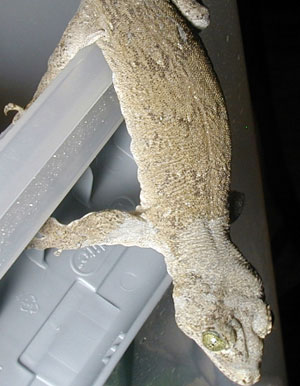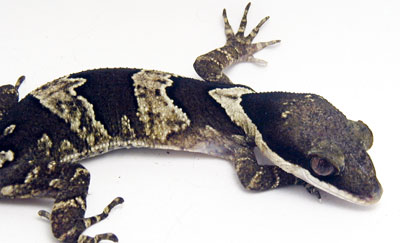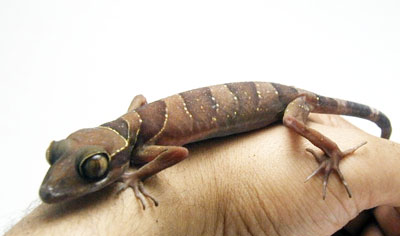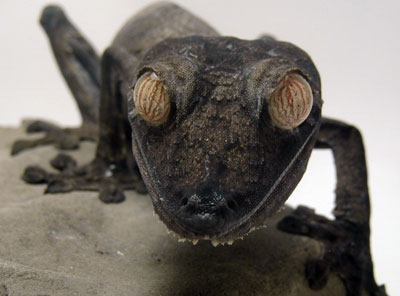Geckos are the most varied group of lizard species on the planet. They inhabit every continent except Antarctica, eat a variety of foods from fruit flies to small birds, live in environments that range from desolate deserts to lush rain forests, and have even, in some species, capitalized on humans’ influence and moved into cities and suburbs around the world. There is a gecko species to fit every lizard keeper’s tastes. For the past 14+ years, I’ve kept and bred Leopard Geckos, Crested Geckos, African Fat Tailed Geckos, and Tokay Geckos on a moderate scale. However, in my thirst for new territory I began looking into other species, those not so often seen at reptile shows and pet stores. I currently maintain 4 species of medium to large geckos that are something a little different, not often seen and that are sometimes overlooked by the average reptile hobbyist.
Knowledge is Power
The most important tool of any reptile keeper’s trade is information — information about an animal. Its natural habitat, feeding preferences, temperature and humidity requirements, and breeding behavior among others are the keys to keeping any species successfully. With the following species, information may be hard to gather. The first thing to do is to try and find someone who already keeps them. Picking the brains of experienced keepers is an excellent way to gain knowledge of the care requirements of any species of animal. Other good sources are care sheets and books specifically keyed towards the genus or species in question. However, with the more unusual species, these can be either non-existent or hard to find. In the event that you cannot find a care sheet or book, looking into the natural habitat of the animal is an excellent way to get a starting point for husbandry. Does it come from a rainforest or desert? What kind of plant life is found there? What niche does it occupy? What are the average daily temperatures and humidity like? These types of questions are key in providing the correct environment for your animal.
“Poor Man’s Leachie” (Gehyra marginata)

This species is probably the easiest of the four to maintain. Gehyra marginata, or the Halmahera Giant Gecko, is often called the “poor man’s leachie” due to their similarities to Rhacodactylus leachianus and their much lower price tag. Commonly mislabeled as “Vorax” geckos, these animals are in fact a different species than Gehyra vorax, which is extremely rare in US collections. The main difference between the two is eye color. G. vorax has amber colored eyes, while the much more commonly seen G. marginata has green. These large, arboreal geckos come from Indonesia, Fiji, Papua New Guinea, and several other islands in that region. They can reach up to 13 inches in length, with the average adult being about 10 inches. These geckos are normally a brown or tan coloration with some saddling, and can become lighter or darker according to the time of day, their mood, temperatures, and other factors.. These lizards are very hardy, and can be maintained similarly to Tokay Geckos. I keep an adult pair in a Rubbermaid container the equivalent of a 30 gallon aquarium. Height is important: these geckos seldom come to the ground. They are normally very shy, and they appreciate many places to hide and lots of things to climb on. I provide large branches about the thickness of my wrist, plastic plants, egg crate, and hollow cork bark tubing to hide in. Substrate is coco fiber over a drainage layer of Hydroton, and is covered sporadically with sphagnum moss. G. marginata are from lush, tropical forests and appreciate high humidity. Heat is provided with a 60 watt nocturnal (red) bulb. These geckos like temperatures in the mid 80’s (F), with a basking spot of 90 F. A water dish is always provided, though they seldom use it. I mist them once a day in the evening to provide an increase in humidity at night.
My Halmahera Giant Geckos are fed a diet consisting of roaches, super worms, and Crested Gecko Diet (CGD). Believe it or not, they prefer the CGD over anything else. I also provide a dish of calcium powder in the cage and have observed the female eating it.
As far as handling goes, use caution when handling this species. Some imported adults can be quite aggressive, and obtaining captive bred animals is always preferable. They are very quick and have delicate skin. It will tear easily so don’t grab them (grabbing is also a good way to elicit a bite). Instead, put a bit of honey on your finger and wait patiently near the gecko. These animals have a real sweet tooth, and honey will go a long way towards earning their trust.
It should be noted that these geckos are highly territorial, and keeping multiple animals together should be done with caution. When pairing animals, watch carefully for signs of incompatibility, and separate immediately if they are seen. Not all pairs are compatible. Once established, a pair will breed year round with some regularity. The eggs are very large and can take up to 5 months to hatch. Hatchlings can be maintained like adults in miniaturized versions of the setup.
These geckos are underrated, in my opinion. They are very easily maintained, extremely hardy, impressive, and have a subtle beauty to them. As with many species that are commonly sold as imports; more efforts need to be made to establish a captive bred population of these amazing geckos.
“Giant Bent Toed” (Cyrtodactylus irianjayaensis)

These are among my favorite geckos. These large, semi-terrestrial geckos are often sold as Giant Bent Toed Geckos, Giant Bow Fingered Geckos, or Giant Ring Tailed Geckos. This species is from Irian Jaya and Papua New Guinea, and is often confused with Cyrtodactylus lousiadensis, an Australian species. The difference can be found in the stripes: irianjayaensis has a jagged edge to the striped markings while lousiadensis has smooth edges. They are a large, robust gecko, with adults reaching over 12 inches. Bent Toed Geckos are still rather rare in collections and more work needs to be done to establish these interesting animals. They come from cool, tropical areas and require high humidity (70-100%). My pair lives in a 106 quart Sterilite container with a mix of peat moss and coco fiber as a substrate. I provide sphagnum moss areas, good sized branches and cork bark along with lots of plants to provide the climbing and hiding options these geckos need. Always provide a hide for these geckos; they require it to feel secure. An interesting fact about this species is that it will soak on a fairly regular basis, so provide a water area large enough for the gecko to fit in it. Misting should be done at least twice a day to maintain high humidity levels.
These geckos are voracious predators and will consume quite large prey items. I offer my Giant Bent Toed Geckos roaches of two species, along with pinkie mice every so often and super worms. Feeders should be dusted with a quality calcium powder at every other feeding, every feeding if the female is laying eggs.
Cyrtodactylus have a reputation for being delicate, but I’ve found these geckos to be hardy and easily kept if the requirements are met. There are many species in this genus, and although not as brightly colored as some geckos, they are all active and inquisitive animals that are a joy to watch at night. Handling is not generally a good idea as it can stress them easily, and all Bent Toed Geckos have large sharp nails and can give a decent bite. Move slowly when working in the cage and always stay within the animal’s comfort zone when handling.
“Grumpy Geckos” (Cyrtodactylus intermedius)

Along with C. irianjayaensis I also maintain Cyrtodactylus intermedius, the Malaysian “Night Stalker” Bent Toed Gecko. These geckos are smaller, with an average size of 8-10 inches, and a much more slender build. Found in Malaysia, these nocturnal lizards are more arboreal than Giant Bent Toed Geckos, and also have a tendency to be more apt to bite. My Night Stalkers will often be heard calling at night. It’s a short, musical chirping sound that is quite charming. These geckos can be maintained nearly identically to C. irianjayaensis, with things scaled down for their smaller size and a bit more attention paid to their climbing preferences. I provide a humid environment that is a tangle of vines and plants with many small branches. Temperatures are kept in the low 70’s, and misting is done twice daily at least.
Night Stalker Bent Toed Geckos will feed on a variety of insect prey. I provide a diet based on roaches, but crickets are accepted just as readily. Calcium supplementation should be provided at least every other feeding. These geckos are active hunters, and it is very interesting to watch them chase down insects in the evening. They spend a lot of time above the ground, and will only retreat to ground hides during the day to sleep. Most animals are imported and come with heavy parasite loads and can be difficult to acclimate. I always attempt to breed these more unusual species, as captive bred animals are superior as pets and it is important to take pressure off of wild populations.
“Living Tree Bark” (Uroplatus fimbriatus)

Leaf Tailed Geckos of the genus Uroplatus are by far my favorite geckos. These animals are camouflage personified: they are perfectly suited to staying hidden in plain sight. Leaf Tailed Geckos hale from the island of Madagascar, and come in a variety of forms. All species of Uroplatus are CITES I listed and are under threat from habitat destruction. The Giant Leaf Tailed Gecko, Uroplatus fimbriatus, is one of the most commonly imported, but is also sadly one of the species least frequently bred in captivity. These large geckos are a wonder to keep, and are very entertaining.
Giant Leaf Tailed Geckos are large geckos, reaching over 12 inches total length. They have very large heads and wide mouths. Uroplatus geckos are unique in that they have the most marginal teeth and the highest number among all living amniotes. They spend their days hanging motionlessly, usually in a head down position. At night, these large geckos come alive, and are active lizards.
I maintain my pair of Uroplatus fimbriatus in a large, all screen, arboreal enclosure. It is 24 inches wide, by 24 inches deep, by 36 inches high. Three sides are covered with plastic to help maintain humidity. Substrate is a bioactive mix of coco fiber, peat moss, and leaf litter covering a drainage layer of hydroton (expanded clay balls). Thick branches provide resting places, although the geckos often prefer to spend their time on the screen sides of the enclosure. Springtails and isopods populate the substrate, allowing for decomposition of wastes. Live plants are provided, consisting of Snake Plants and Pothos, along with plastic plants for more cover. Temperatures for Giant Leaf Tailed Geckos can range from 68-79F, with the low to mid 70s being ideal. I provide a large water dish with an air stone attached to an aquarium air pump to roil the surface and encourage drinking. Hydration is very important with these geckos, as they have thin, delicate skin. My Giant Leaf Tails are misted twice a day; once lightly in the morning and again heavily for 5-10 minutes right after lights out. The key is to provide a 90-100% humidity environment at night while allowing the cage to dry out during the day to prevent mold growth. Screen caging can make it difficult to maintain this in some cases, but by of blocking some of the screen and careful misting the appropriate environment can be maintained. These large geckos do best when kept cool with high humidity and still preventing air from becoming stagnant.
Roaches are the Uroplatus keepers’ best friend. These large geckos really are too big for crickets, and roaches elicit an excellent feeding response and are a great staple diet. Giant Leaf Tailed Geckos will ignore prey that is too small and will rarely eat any sort of “worm” like superworms or mealworms. Calcium levels are key in breeding females, and I supplement roaches every feeding.
Giant Leaf Tailed Geckos are not a beginner species, but once you do your research, familiarize yourself with the genus, and have the correct requirements, healthy animals are fairly easy to maintain. Breeding is somewhat of a challenge with this species. Some Uroplatus keepers adovocate Full Spectrum UVB lighting with Leaf Tailed Geckos, and I agree. My adults are given 12 hour exposure daily to a 5.0 UVB bulb and thrive with it. These geckos are rarely bred in captivity, and it is imperative that more captive bred animals be established. Madagascar’s forests are in great peril, and the flow of imports will not be there forever.
So there you have it; four “oddball” gecko species. These are all geckos that have their own individual aspects that make them a joy to keep. Every day is a wonder for me as I enter my reptile room to see parts of the world from all over ensconced in one room. Every second I spend with these animals I am learning more about them, and attempt to practice better husbandry and, with work, breed them so that I can do my part to lessen the pressure on wild populations. So, the next time you are in the market for a gecko, consider something a bit different. You might be surprised at just how incredible an oddball can be.


The price for Leachies is slowly reducing, soon the Halmahera Giant Gecko may have some tighter competition.
I’m a big fan of the Gehyra marginata as well.
Nice article about some not-so-often seen species.
Thanks for the comments Whitney & Wally! Also, big thanks to Ted for writing the awesome article.
I just purchased what was suppose to be g. vorax but after reading your article I now know I have G. marginata as mine are white with green eyes but either way they are cool and am extremely happy with them
I’m glad everyone enjoyed the article, thanks for the comments.
Chris I’m glad I could help you properly ID your animals. Unfortunately G. marginata is commonly mislabled as G. vorax by importers. Regardless, they are hardy animals that are a joy to work with. I have found them extremely easy to maintain and breed and hope that their popularity will continue to grow.
Very interesting article. The Leaf Tails are a species that I’ve always had in interest in.
Great articles; I was especially interested in the leaf tails. I will definitely be back.